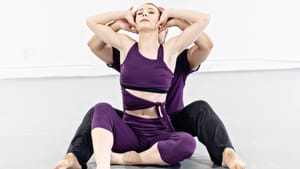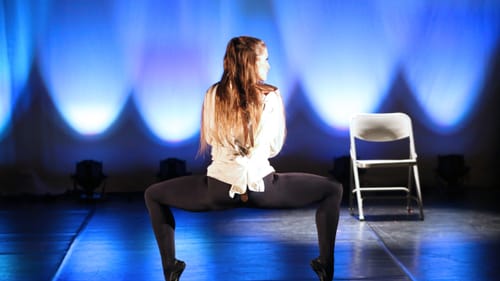Stay in the Loop
BSR publishes on a weekly schedule, with an email newsletter every Wednesday and Thursday morning. There’s no paywall, and subscribing is always free.
A revival and a premiere
SHARP Dance Company presents Stories

For its fall series at Christ Church Neighborhood House, SHARP Dance Company offered a mix of wonderful pieces interspersed with shorter pieces that did not quite fulfill their aspirations.
Founder and artistic director Diane Sharp-Nachsin originally choreographed Building Blocks, set to the music of Depeche Mode, in 2007. She revised the piece as a tribute to the band’s Andy Fletcher, who died in May of this year, and the dance is driven by the band’s almost clocklike New Wave beat mixed with a sly sensuality.
It opens on an empty stage with scattered blocks of light, the largest at the front on our left and two actual blocks at the back. A trio of dancers in knee-length red dresses danced around and over the blocks, and were joined by the rest of the company in an explosion of red. In a striking trio, Rosemary Scalise and Sandra Davis, with Wren Coleman in black pants and a white shirt, performed a series of varied moves that became one diagonal line in perfect unison without our quite seeing how it happened. I loved the take-charge sensuality as well, the deep plies of the women in red and the sinuous curve as they contracted their core from the chest through the gut as they passed, one by one, through the lighted block at the front of the stage.
The dance of gender
Often, we hear the term “dance is universal,” while the tyranny of style ties us up in narrow expectations based on an accident of birth: we costume one type of body to showcase curves, and put another on the stage shirtless and in tights or in loose pants and shirts, and choreographers struggle to break out of those unquestioned social roles, or think beyond a gender binary. So, how can this most embodied art better express the shaky ground that gender stands on?
Joe Cotler’s Chosen confronts those gender stereotypes, nowhere more ably than in a trio performed by Juliet Bernstein, Miguel Quiñones, and Coleman, all in dark pants and blue shirts. Set to the abrasive electronica of Abom Tobin, the trio was tight, abrupt, aggressive. The dancers’ legs seemed to dig into the stage, their arms pushing rather than reaching, clasped in front of them as they paced in a sweeping circle or bent at the elbows like flexed muscles. It’s the sort of piece we mark as “male,” for its power, but each of the dancers was as strong as the others. Nor were the women in blue-green dresses left behind: they performed low lifts and deep plies, with arms held low, palms out in front of them, making their sexuality a challenge. It was one of those standout pieces that make you think and feel at the same time.
Stories worth the wait
Sharp-Nachsin’s anticipated Stories ended the evening and it was worth the wait. The program explained the work as the stories of our passage through Covid-19—how we think about our lives now and how it has changed our relationships. Fittingly, solos highlighted Part 1, with music by J and the dancers in body-hugging purple, slashed shirts for some and black pants and purple shirts for others. I had been looking forward to seeing Coleman dance again and his solo fulfilled my expectations. Given a chance to shine, he is luminous.
In Part 2, Cotler gave us a duet of mature sensuality in floor work, a lived relationship performed by Bernstein and Quiñones. At times, the dancers seemed so enmeshed they could have been one person; at others, you could feel the tension as Bernstein seemed to turn Quiñones away. In Sharp-Nachsin’s Part 3, set to music by Dalby, dancers leaped across the stage like splinters of purple light, or crossed the stage in low lunges. I have a longstanding love of work done in tight unison and Part 3 gave us the tightest formations—with kicks and outstretched arms raised high so they crossed their neighbor’s reach. After isolation, it seemed to say, we have come together again. Gorgeous!

Shorter works
Three shorter pieces were interspersed throughout the program. “Unguarded Moment” from Sharp-Nachsin’s Madness gave us Sandra Davis in pointe shoes escaping a straitjacket. Davis performed balance moves around a chair and some interesting footwork, but the straitjacket constrained the dancer to a vertical axis that did not project the kind of dynamism a shifting orientation in the space can give a performance. Separated from its story, it seemed more interesting intellectually than emotionally—something I hope is not a trend.
Roller Coaster Rules, performed to the voiceover reading of the rules for the ride, gave a comic palate cleanser before the intermission, but Steven Vaughn’s Boatman, about death and crossing over, felt too undeveloped for the impact it should have had. But the evening belonged to the three longer pieces.
What, When, Where
Stories. Choreography by Diane Sharp-Nachsin, with guest choreographers Joe Cotler and Steven Vaughn. $25-$35. SHARP Dance Company. November 11-13, 2022, at Christ Church Neighborhood House, 20 N. American Street, Philadelphia. (215) 880-2306 or sharpdance.org.
Accessibility
Christ Church Neighborhood House is an ADA-compliant venue. There is an elevator to the fourth floor, where the theater space is located, and wheelchair seating is available upon request.
Sign up for our newsletter
All of the week's new articles, all in one place. Sign up for the free weekly BSR newsletters, and don't miss a conversation.

 Camille Bacon-Smith
Camille Bacon-Smith